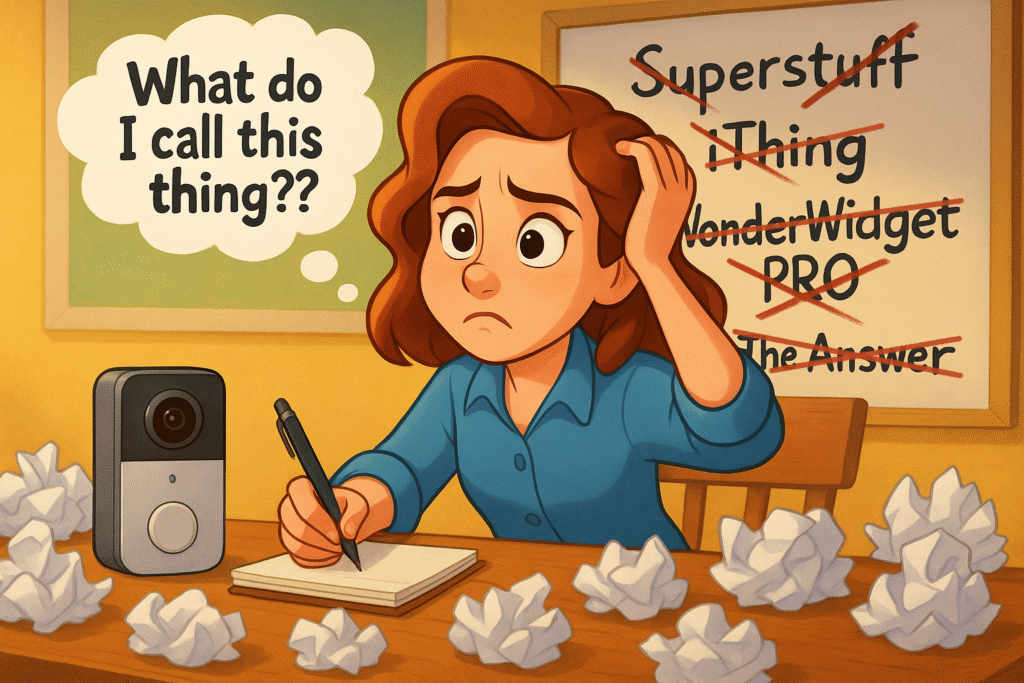
I’ve been working on a launch project for a consumer product client with an enviable situation: their product name perfectly encapsulates what it does.
It’s rare gold in product marketing.
Names are bigger than the words you choose. They’re compact bundles of meaning that trigger instant associations, emotions, and expectations before a customer ever interacts with your product.
Some companies spend hundreds of thousands on naming consultants. Others blunder into brilliance.
But the psychology behind effective product naming is more science than art.
Consider my B2B client REGEN Fiber — a construction reinforcement product made from recycled wind turbine blades. The name does some heavy lifting:
“REGEN” connects to both regeneration (giving materials new life) and the original purpose of the materials (generating green energy). “Fiber” clearly communicates the product category while feeling technical and precise. (I love that it’s an SEO keyword, right in the domain. Very helpful for being found, but often not this practical.)
In a single term, they’ve conveyed sustainability, purpose, and function — smashing the perfect trifecta that resonates with their target audience’s values and needs.
Not every successful name is so literal.
Sometimes grabbing the right sentiment harnesses huge power. Slack brilliantly redefined a negative term (“slacking off”) into a positive one for their workplace communication platform.
The name cleverly suggests creating “slack” in your workday — less tension, more breathing room — while being memorable precisely because it subverts expectations.
Square (now Block) chose a name that communicated simplicity and stability for their payment processing system. The geometric shape suggests the perfect “fit” for small businesses, while being instantly recognizable and descriptive of their original card reader. The plan four years ago was to fully change to the new name, but Square was just too good.
Peloton borrowed from the French word for “platoon” or group of cyclists riding together. Maybe it didn’t mean anything to you, but that’s not an issue.
For target customers like me who are familiar with cycling, it immediately communicated the community aspect that differentiates the product from ordinary exercise bikes.
A name doesn’t have to be packed with meaning, either. Nearly all popular words are taken as trademarks or domains. That can hurt you in branding and IP protection.
Lululemon took a sort of opposite approach — a completely new and meaningless name chosen partially because founder Chip Wilson knew Japanese consumers didn’t often see or hear the letter “L.” He explained in his book and at an event where I saw him in person that he’d insisted on Ls for that very reason, and two was doubly good to succeed with that target market. The name created a blank slate with no pre-existing associations, allowing the brand to build meaning from scratch.
In I Need That, I discuss how the dog brain (our emotional, impulsive system) makes snap judgments that our analytical mind later justifies. Your product name is among the first things this quick-fire system evaluates — and first impressions are notoriously difficult to reverse.
When testing names, those first impressions are huge.
A great name connects directly with your positioning and resonates with your audience’s values. It also helps overcome the status quo bias by making your innovation feel familiar enough to be approachable, yet novel enough to be interesting. The brain craves both.
Product Payoff: Think about how Zoom is a perfect case study in effective naming. When entering the crowded video conferencing market dominated by established players like Skype and WebEx, the founders chose a name that communicated speed, ease, simplicity, and directness. “Zoom” suggests getting from point A to B quickly — EXACTLY what users said they wanted from a video call. This clear, action-oriented name aligned perfectly with their key differentiator (ease of use) and helped them capture market share at an unprecedented rate, eventually becoming so successful that the brand name became a verb. Would you rather “Zoom” or “see if we can all meet on Teams“?
Action for today: Evaluate your product name against these four criteria:
- Memorability: Can people recall it after hearing it once? (And can they guess how to spell it?)
- Appropriateness: Does it match your positioning and audience’s values?
- Distinctiveness: Is it different enough from competitors to stand out? Does it sound preferable?
- Future-proofing: Will it still work when you expand beyond your initial offering?
If your product name falls short on any of these dimensions, consider whether a naming adjustment might be warranted before you’ve invested too heavily in brand equity.
What’s the best (or worst) product name you’ve encountered recently?
What are you working on now? Need objective thoughts?
Tap that reply arrow and let me know. (My lips are sealed.)
Or reach out to my amazing team of product name development experts at Graphos Product.
